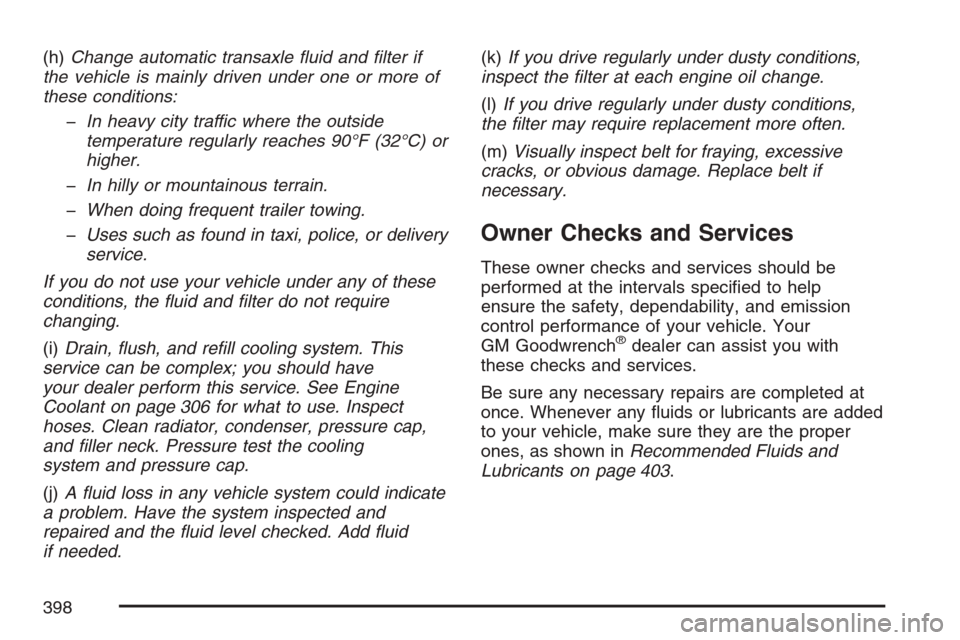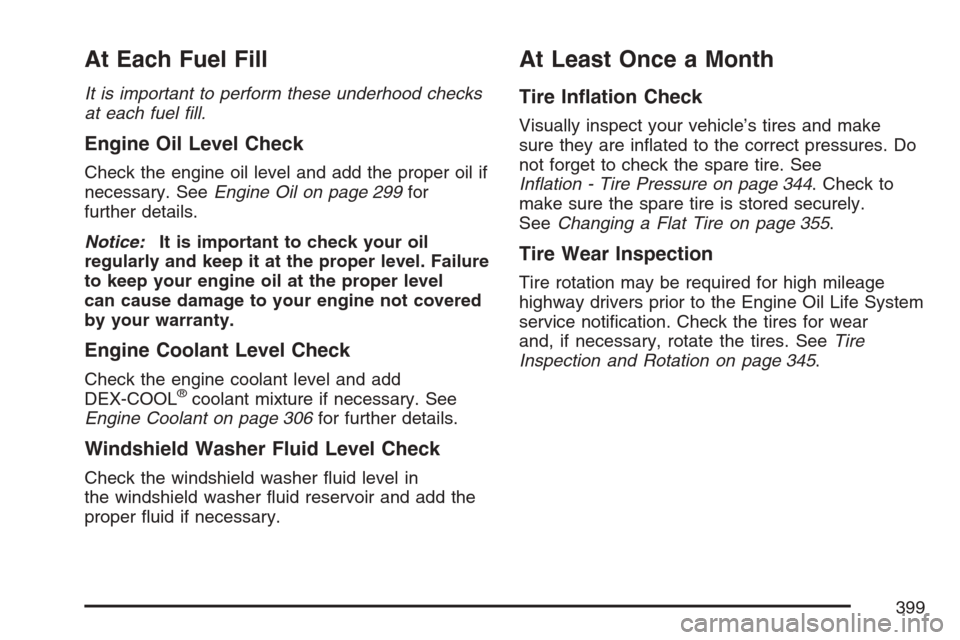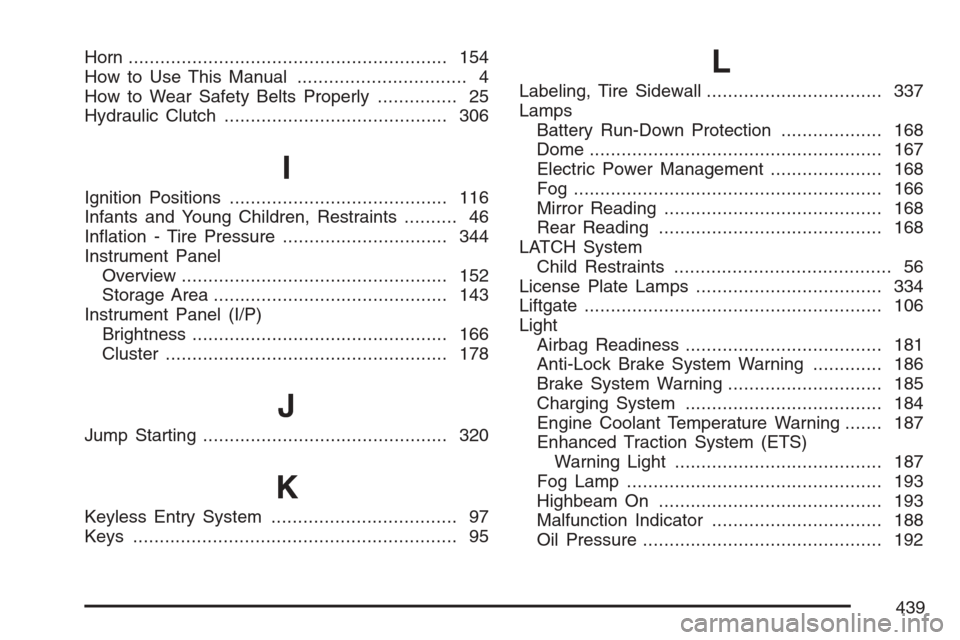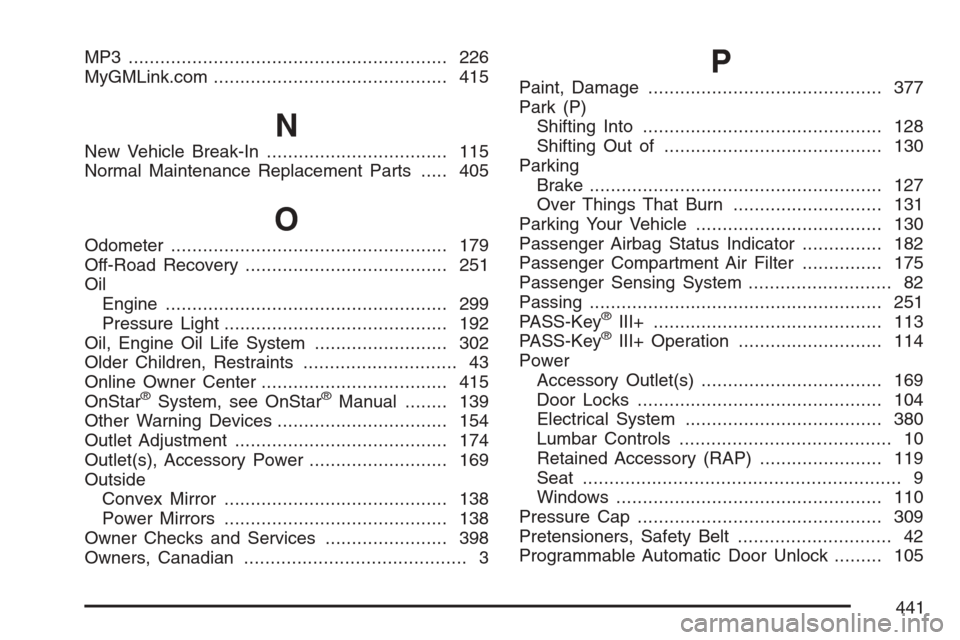2007 CHEVROLET HHR oil pressure
[x] Cancel search: oil pressurePage 341 of 446

Aspect Ratio:The relationship of a tire’s height
to its width.
Belt:A rubber coated layer of cords that is
located between the plies and the tread. Cords
may be made from steel or other reinforcing
materials.
Bead:The tire bead contains steel wires wrapped
by steel cords that hold the tire onto the rim.
Bias Ply Tire:A pneumatic tire in which the plies
are laid at alternate angles less than 90 degrees
to the centerline of the tread.
Cold Tire Pressure:The amount of air pressure
in a tire, measured in pounds per square inch
(psi) or kilopascals (kPa) before a tire has built up
heat from driving. SeeInflation - Tire Pressure
on page 344.
Curb Weight:This means the weight of a motor
vehicle with standard and optional equipment
including the maximum capacity of fuel, oil, and
coolant, but without passengers and cargo.DOT Markings:A code molded into the sidewall
of a tire signifying that the tire is in compliance
with the U.S. Department of Transportation (DOT)
motor vehicle safety standards. The DOT code
includes the Tire Identi�cation Number (TIN),
an alphanumeric designator which can also identify
the tire manufacturer, production plant, brand,
and date of production.
GVWR:Gross Vehicle Weight Rating. See
Loading Your Vehicle on page 269.
GAWR FRT:Gross Axle Weight Rating for the
front axle. SeeLoading Your Vehicle on page 269.
GAWR RR:Gross Axle Weight Rating for the
rear axle. SeeLoading Your Vehicle on page 269.
Intended Outboard Sidewall:The side of an
asymmetrical tire, that must always face outward
when mounted on a vehicle.
Kilopascal (kPa):The metric unit for air pressure.
341
Page 371 of 446

Do not clean your vehicle using the following
cleaners or techniques:
Never use a knife or any other sharp object to
remove a soil from any interior surface.
Never use a stiff brush. It can cause damage
to your vehicle’s interior surfaces.
Never apply heavy pressure or rub
aggressively with a cleaning cloth. Use of
heavy pressure can damage your interior and
does not improve the effectiveness of soil
removal.
Use only mild, neutral-pH soaps. Avoid
laundry detergents or dishwashing soaps with
degreasers. Using too much soap will leave
a residue that leaves streaks and attracts dirt.
For liquid cleaners, about 20 drops per
gallon (3.78 L) of water is a good guide.
Do not heavily saturate your upholstery while
cleaning.
Damage to your vehicle’s interior may result
from the use of many organic solvents such
as naptha, alcohol, etc.
Fabric/Carpet
Use a vacuum cleaner with a soft brush
attachment frequently to remove dust and loose
dirt. A canister vacuum with a beater bar in
the nozzle may only be used on �oor carpet and
carpeted �oor mats. For soils, always try to remove
them �rst with plain water or club soda. Before
cleaning, gently remove as much of the soil
as possible using one of the following techniques:
For liquids: gently blot the remaining soil
with a paper towel. Allow the soil to absorb into
the paper towel until no more can be
removed.
For solid dry soils: remove as much as
possible and then vacuum.
To clean, use the following instructions:
1. Saturate a lint-free, clean white cloth with
water or club soda.
2. Wring the cloth to remove excess moisture.
3. Start on the outside edge of the soil and gently
rub toward the center. Continue cleaning,
using a clean area of the cloth each time it
becomes soiled.
371
Page 395 of 446

Scheduled Maintenance
Service MaintenanceIMaintenanceII
Change engine oil and �lter. SeeEngine Oil on page 299. Reset oil life system.
SeeEngine Oil Life System on page 302.An Emission Control Service.••
Visually check for any leaks or damage.See footnote (j).••
Inspect engine air cleaner �lter. If necessary, replace �lter. SeeEngine Air
Cleaner/Filter on page 304.See footnote (k).•
Rotate tires and check in�ation pressures and wear. SeeTire Inspection and
Rotation on page 345and “Tire Wear Inspection” inAt Least Once a Month
on page 399.••
Inspect brake system.See footnote (a).••
Check engine coolant and windshield washer �uid levels and add �uid as
needed.••
Perform any needed additional services. See “Additional Required Services”
in this section.••
Inspect suspension and steering components.See footnote (b).•
Inspect engine cooling system.See footnote (c).•
Inspect wiper blades.See footnote (d).•
Inspect restraint system components.See footnote (e).•
Lubricate body components.See footnote (f).•
Replace passenger compartment air �lter.See footnote (l).•
Inspect throttle system.See footnote (g).•
395
Page 398 of 446

(h)Change automatic transaxle fluid and filter if
the vehicle is mainly driven under one or more of
these conditions:
�In heavy city traffic where the outside
temperature regularly reaches 90°F (32°C) or
higher.
�In hilly or mountainous terrain.
�When doing frequent trailer towing.
�Uses such as found in taxi, police, or delivery
service.
If you do not use your vehicle under any of these
conditions, the fluid and filter do not require
changing.
(i)Drain, flush, and refill cooling system. This
service can be complex; you should have
your dealer perform this service. See Engine
Coolant on page 306 for what to use. Inspect
hoses. Clean radiator, condenser, pressure cap,
and filler neck. Pressure test the cooling
system and pressure cap.
(j)A fluid loss in any vehicle system could indicate
a problem. Have the system inspected and
repaired and the fluid level checked. Add fluid
if needed.(k)If you drive regularly under dusty conditions,
inspect the filter at each engine oil change.
(l)If you drive regularly under dusty conditions,
the filter may require replacement more often.
(m)Visually inspect belt for fraying, excessive
cracks, or obvious damage. Replace belt if
necessary.
Owner Checks and Services
These owner checks and services should be
performed at the intervals speci�ed to help
ensure the safety, dependability, and emission
control performance of your vehicle. Your
GM Goodwrench
®dealer can assist you with
these checks and services.
Be sure any necessary repairs are completed at
once. Whenever any �uids or lubricants are added
to your vehicle, make sure they are the proper
ones, as shown inRecommended Fluids and
Lubricants on page 403.
398
Page 399 of 446

At Each Fuel Fill
It is important to perform these underhood checks
at each fuel fill.
Engine Oil Level Check
Check the engine oil level and add the proper oil if
necessary. SeeEngine Oil on page 299for
further details.
Notice:It is important to check your oil
regularly and keep it at the proper level. Failure
to keep your engine oil at the proper level
can cause damage to your engine not covered
by your warranty.
Engine Coolant Level Check
Check the engine coolant level and add
DEX-COOL®coolant mixture if necessary. See
Engine Coolant on page 306for further details.
Windshield Washer Fluid Level Check
Check the windshield washer �uid level in
the windshield washer �uid reservoir and add the
proper �uid if necessary.
At Least Once a Month
Tire In�ation Check
Visually inspect your vehicle’s tires and make
sure they are in�ated to the correct pressures. Do
not forget to check the spare tire. See
Inflation - Tire Pressure on page 344. Check to
make sure the spare tire is stored securely.
SeeChanging a Flat Tire on page 355.
Tire Wear Inspection
Tire rotation may be required for high mileage
highway drivers prior to the Engine Oil Life System
service noti�cation. Check the tires for wear
and, if necessary, rotate the tires. SeeTire
Inspection and Rotation on page 345.
399
Page 439 of 446

Horn............................................................ 154
How to Use This Manual................................ 4
How to Wear Safety Belts Properly............... 25
Hydraulic Clutch.......................................... 306
I
Ignition Positions......................................... 116
Infants and Young Children, Restraints.......... 46
In�ation - Tire Pressure............................... 344
Instrument Panel
Overview.................................................. 152
Storage Area............................................ 143
Instrument Panel (I/P)
Brightness................................................ 166
Cluster..................................................... 178
J
Jump Starting.............................................. 320
K
Keyless Entry System................................... 97
Keys............................................................. 95
L
Labeling, Tire Sidewall................................. 337
Lamps
Battery Run-Down Protection................... 168
Dome....................................................... 167
Electric Power Management..................... 168
Fog .......................................................... 166
Mirror Reading......................................... 168
Rear Reading.......................................... 168
LATCH System
Child Restraints......................................... 56
License Plate Lamps................................... 334
Liftgate........................................................ 106
Light
Airbag Readiness..................................... 181
Anti-Lock Brake System Warning............. 186
Brake System Warning............................. 185
Charging System..................................... 184
Engine Coolant Temperature Warning....... 187
Enhanced Traction System (ETS)
Warning Light....................................... 187
Fog Lamp................................................ 193
Highbeam On.......................................... 193
Malfunction Indicator................................ 188
Oil Pressure............................................. 192
439
Page 441 of 446

MP3 ............................................................ 226
MyGMLink.com............................................ 415
N
New Vehicle Break-In.................................. 115
Normal Maintenance Replacement Parts..... 405
O
Odometer.................................................... 179
Off-Road Recovery...................................... 251
Oil
Engine..................................................... 299
Pressure Light.......................................... 192
Oil, Engine Oil Life System......................... 302
Older Children, Restraints............................. 43
Online Owner Center................................... 415
OnStar
®System, see OnStar®Manual........ 139
Other Warning Devices................................ 154
Outlet Adjustment........................................ 174
Outlet(s), Accessory Power.......................... 169
Outside
Convex Mirror.......................................... 138
Power Mirrors.......................................... 138
Owner Checks and Services....................... 398
Owners, Canadian.......................................... 3
P
Paint, Damage............................................ 377
Park (P)
Shifting Into............................................. 128
Shifting Out of......................................... 130
Parking
Brake....................................................... 127
Over Things That Burn............................ 131
Parking Your Vehicle................................... 130
Passenger Airbag Status Indicator............... 182
Passenger Compartment Air Filter............... 175
Passenger Sensing System........................... 82
Passing....................................................... 251
PASS-Key
®III+........................................... 113
PASS-Key®III+ Operation........................... 114
Power
Accessory Outlet(s).................................. 169
Door Locks.............................................. 104
Electrical System..................................... 380
Lumbar Controls........................................ 10
Retained Accessory (RAP)....................... 119
Seat............................................................ 9
Windows.................................................. 110
Pressure Cap.............................................. 309
Pretensioners, Safety Belt............................. 42
Programmable Automatic Door Unlock......... 105
441